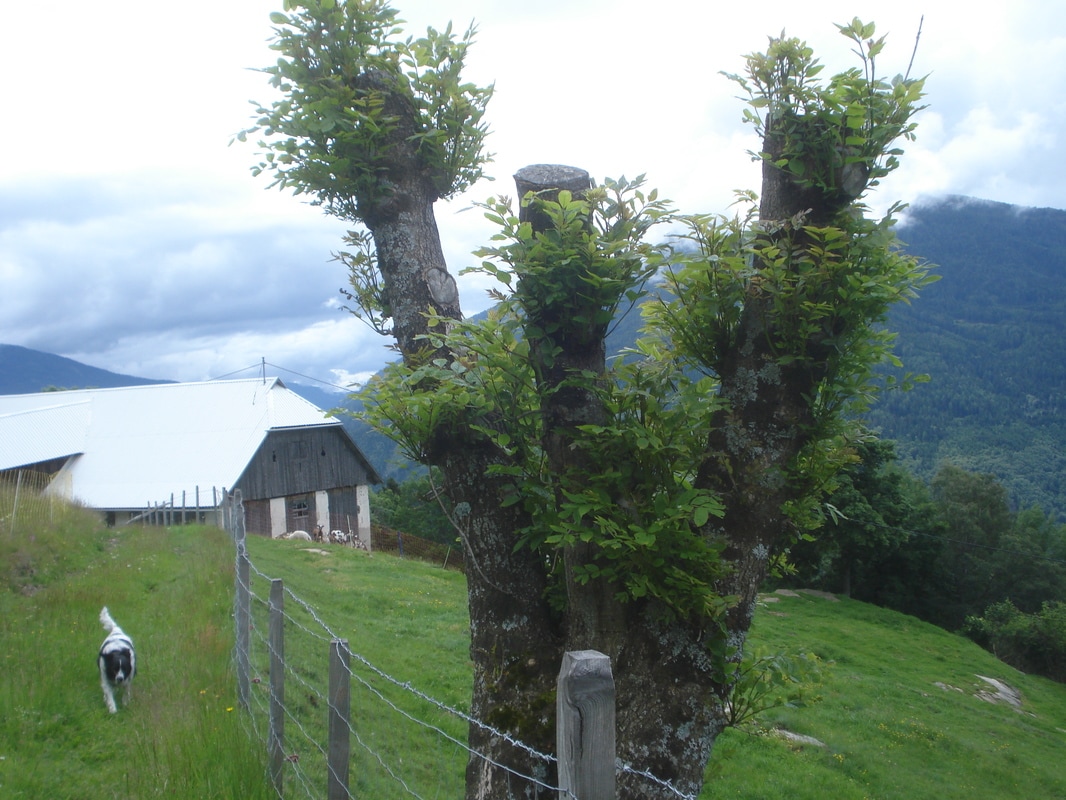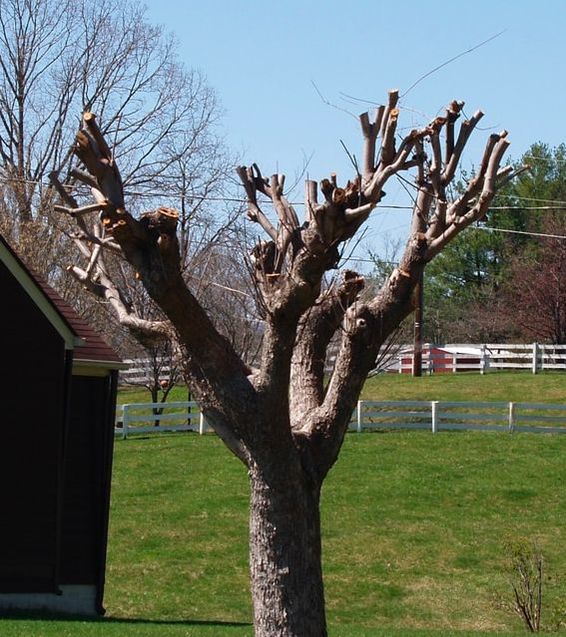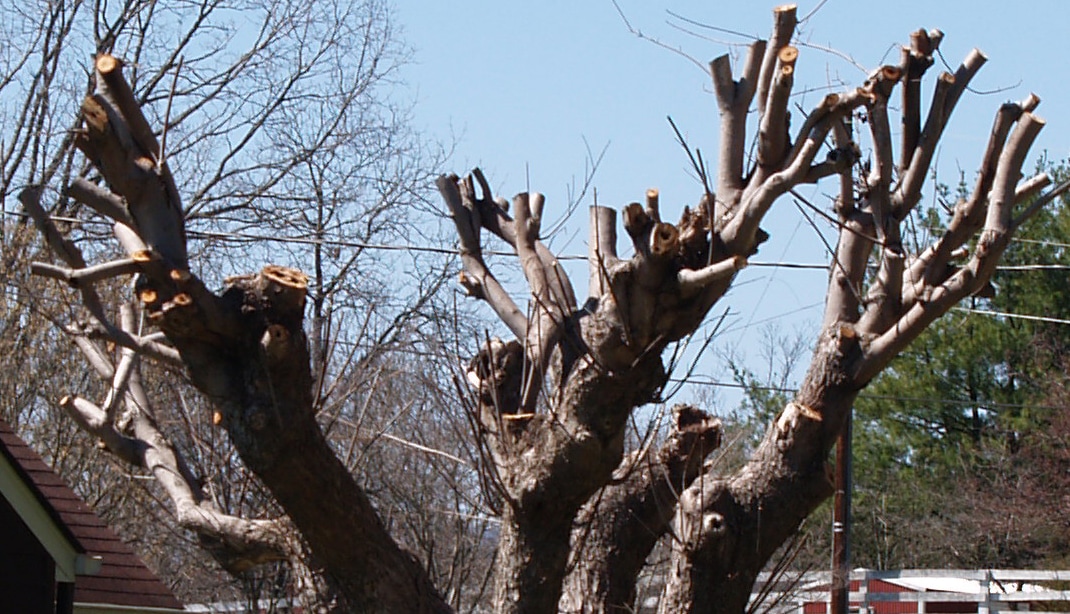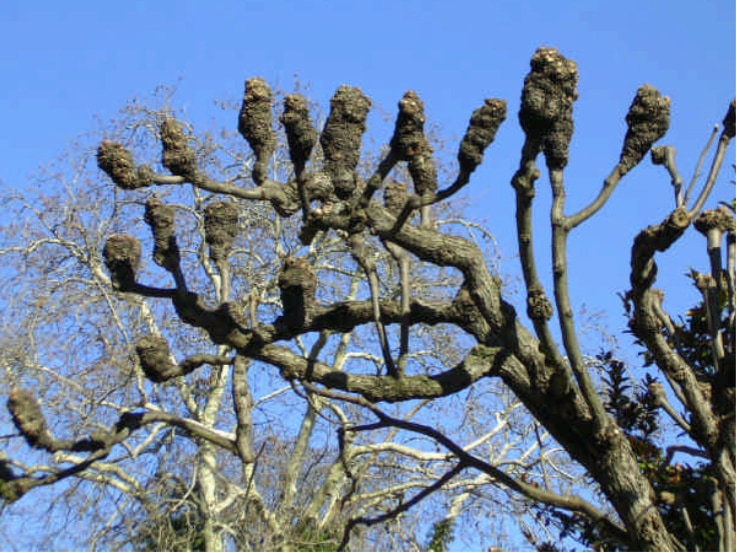Pollarding Physiology and Practice Update By Dave Jacke In researching Coppice Agroforestry, we have struggled to find the kind of information we want and need about the resprouting of woody plants. However, we have succeeded in gathering significant numbers of informational “needles” about coppicing biology and ecology from a large haystack of sources. This is allowing us to pull together a pretty solid picture of the fundamental biology and ecology of sprouting. For example, we have synthesized a comprehensive framework of the kinds of buds that woody plants produce and their origins, functions, and physiology, and we have a sense of how this framework can help guide management practices. Until recently though, we had far more information concerning coppicing—that is, the cutting of trees or shrubs to the ground or just above the ground for purposes of harvesting woody resprouts ad infinitum—than we have found on pollarding. Pollarding would seem to be the same as coppicing, except elevated above the ground. Indeed, that is even how some people in Austria practice it (Figure 1). However, Mark and I have heard from various people and authors that pollarding is a training system not a pruning technique, but these same people gave us precious little practical information to go on for how one trains a pollard in the first place. In my travels around the world since we started work on this book, I have seen plenty of examples of people “pollarding” when really what they were doing was “topping”—or in some cases simply hacking at—trees and shrubs without understanding the physiological consequences that follow. Any arborist worth their salt seriously frowns on topping trees and letting them resprout, despite its frequency in, for example, Virginia (see Fig. 2), where I have seen it a lot. This practice consists of what arborists call “heading cuts,” where one cuts a branch or stem back to a stub, or to a lateral branch too small to assume the “terminal role” for that shoot. Most often the heading cut is made on a fairly large shoot that has already developed heartwood to one degree or another. When heartwood is exposed in this way, it tends to rot. The larger the stem diameter when the cut is made, the longer it takes for callus tissue to cover the wound and the more chances fungi and insects will have to get into the wood. Once rot gets into the tree, the tree will never heal. Woody plants do not heal, they compartmentalize. They have various “walls” they use to compartmentalize, but these walls operate most effectively only in living tissue, which heartwood is not.[i] A closer look at the cut stubs in Figure 2 (see Fig. 3) shows that heartwood rot is well underway in this specimen, and that there is little “system” to the pattern of cutting when the stems are pruned off. In contrast, pollarding as a training system involves planned cuts that leave a tree or shrub with “heads” or knobs of callus tissue that sprout continuously and yet prevent rot from getting into the stem. "Woody plants do not heal, they compartmentalize." I recently connected with Andrew Lyman, a board certified Master Arborist with years of experience managing a grove of pollarded European lindens (Tilia cordata) at an Italian Water Garden in southeastern Pennsylvania. These lindens are pollarded to keep the trees to a size and shape that meets the aesthetic goals of this garden. Andrew reiterated that pollarding is a training system that involves planning far ahead: one must start pollarding when the tree is young, or at least when the shoots to be pollarded are young and vigorous and have not yet developed heartwood. This is critical because when the full shoot diameter at the time and place of cutting contains living wood throughout, there is no heartwood available for infection by decay organisms, the living wood can resist decay effectively until it calluses over, and the wound can callus over in a short time, reducing the chance of decay entering the stem. To develop an effective pollard, one must use the first several years of a tree’s life to develop the overall form and architecture desired—forming scaffold branches at the right heights and spacing, for example. If you plan on cutting the pollards every year the branches can be closer together. If you plan on cutting the pollards every two or three years for fodder production, the branches and pollard heads will need to be further apart vertically and horizontally. The initial pollard cuts are topping or heading cuts made on small diameter shoots during the dormant season. Cut back to a point between nodes (leaf attachment points) on the shoot, that is, somewhere on the stem between the places where one or more leaves or side shoots attach to the main shoot. Each node also typically includes one or more axillary bud(s), which establish in the leaf axils when the parent shoot elongates—and often remain dormant until the tree is disturbed. If you cut back to a node, the axillary bud(s) at the node will grow vigorously and become the apex or leader of the stem, which is not what we want. We want the pruning wound to callus over and begin forming a “head” or knob of callus tissue from which adventitious shoots will grow. Unlike axillary buds, adventitious shoots form de novo (Latin, “anew”) from undifferentiated cells in the lateral portion of the stem, typically cambial tissue or callus tissues that cover wounds. The callus of some species (notably, most species of Quercus, Platanus, and Tilia, and some species of Acer, Alnus, Fraxinus, Liriodendron, Morus, and Ulmus) has a high tendency to form adventitious buds and shoots, and these are the best species for pollarding. In addition, dormant axillary buds near the head may sprout, and some may remain dormant while also multiplying, increasing the long-term sprouting potential of the plant. However, epicormic sprouts on the branch below the head are typically stripped off (not cut off) in an attempt to rip out any dormant buds at the base of these shoots. This may be for aesthetic or structural reasons, or it may increase the growth potential of the sprouts from the pollard head—I am at present unclear on why this is done. In any case, after the initial cuts are made, the wound will callus over and sprouts will grow just below and on the wound tissue. “A tree responds to pollarding by building a dense mass of woody fibers around the cutting points. This bulky mass resists decay and effectively divides the vigorous juvenile growth from the aging stem. Hence, the defensive and structural integrity of the tree is maximized using this pruning system because pruning cuts are made when biological reactivity of the trees is quite high and living cells quickly react to wounds and environmental changes and can develop a strong defensive reaction.” During subsequent dormant seasons, the sprouts on and near the head are cut back to the base of the shoot at the head, according to some authors,[iii] or to the first or second axillary bud on the sprout shoot above the head, according to Andrew Lyman. It appears that the base of any shoots growing off the head can or usually contains additional latent buds that formed when the shoot grew originally. These can remain dormant but still multiply in response to the experience of the sprouts getting pruned off, forming “collars” of latent buds on the pollard head. The callus tissue will keep growing over time, covering the wounds of each pruning experience, so that in a few years the head will be larger in diameter than the stem upon which it grows (Figure 4). It is critical that the callus tissue itself not get damaged during pruning! If the head is damaged numerous fine sprouts will grow from the newly wounded callus, but these often die within their first growing season, at least on Tilia cordata. According to Andrew Lyman, it works much better if the subsequent sprouts are actually axillary bud sprouts off the original shoots that grew from the pollard head. This concurs with our observations of adventitious shoots in general, that they tend not to be well attached to the tree, they often grow very thinly, and lack vigor—but this seems to depend on the species in question. If the subsequent shoots are actually from axillary buds, then they will probably grow much more vigorously and remain more firmly attached to the branch or head. Presumably the stubs of the shoots cut off the head will be subsumed by continued expansion of the pollard head, and that should reinforce the physical attachment of the stubs to the head.
So there you have it! This is what we have learned so far about forming pollards, though we are sure there is more to come now that we have cracked the egg open. I am about to travel to Colonial Williamsburg (Virginia), where, I recently learned, they have 30-50 very longstanding chaste tree (Vitex agnus-castus) pollards, and four large sycamore (Platanus occidentalis) pollards, both of which they use for making wattle fences, basketry, garden trellising, crafts, and kindling. I hope to learn more from their experience that we can share with you. As always, thanks for your support and interest! [i] For more information about Compartmentalization of Decay in Trees (CODIT) and the four walls, see Shigo, Alex. 1986. A New Tree Biology: Facts, Photos, and Philosophies on Trees and Their Problems and Proper Care. Durham, NH: Shigo & Trees Assoc. [ii] Ferrini, Francesco. 2006. Pollarding and its effects on tree physiology : a look to mature and senescent tree management in Italy. 1er coloque européen sur les trognes, Vendome, 26, 27 et 28 octobre 2006. https://www.researchgate.net/publication/238712279_Pollarding_and_its_effects_on_tree_physiology_a_look_to_mature_and_senescent_tree_management_in_Italy, accessed April 27, 2017. [iii] See, for example, Gilmore, Edward F. 2011. An Illustrated Guide to Pruning. Clifton Park, NY: Cengage Learning, Inc.
14 Comments
Charles gardner
5/31/2017 04:10:44 am
Ty that was very informing and I plan to make use of the knowledge this winter with new cited cuts and trying new sycamores
Reply
9/23/2018 01:43:36 pm
More and more people should be encouraged to plant trees. It is a shame that those who have power are abusing it by destroying the environment. A great example would be when a corporation wants to branch out in rural areas and for them to construct their building, they will need to cut off lots of trees to make way for their building. This is so disappointing because they are more concerned with their business than the damage they are doing to our environment. And as much as people want to stop them, they do not have the power to do so.
Reply
Chris
8/4/2017 06:08:55 am
Fascinating details.
Reply
Mick
1/3/2018 07:54:50 am
Fascinating indeed.
Reply
1/5/2018 10:08:13 am
ran across any pollard Carolina Basswoods? (Tilia americana
Reply
Lee
5/8/2018 05:30:26 pm
Thanks for this article, Dave. I've made much use ideas gleaned from previous blog posts (thanks Mark!) This one has proven particularly fruitful food for thought. It's helped me to see the potential overlap between my own conservative pruning practice and the sometimes severe rejuvenation-focused pruning that is recommended by some for ornamental gardens. I continue to look forward to the next post and the book!
Reply
Ben Nicholson
11/23/2019 09:33:50 am
Hi Dave,
Reply
1/17/2023 08:40:57 pm
The science of arboriculture studies how trees grow and respond to their environments, as well as the techniques used to cultivate them.
Reply
3/25/2023 08:31:41 am
Such a nice read. I enjoy reading this post!
Reply
4/19/2023 09:01:54 pm
A superbly written article, if only all bloggers offered the same content as you, the internet would be a far better place.
Reply
4/24/2023 10:03:37 pm
Thanks for this great info of yours. This is so much a lot to do with my life. Lifesaver. Keep sharing with us!
Reply
Griffen
7/11/2023 11:21:24 pm
I would love a diagram of the following to make sure I have it right.
Reply
1/20/2024 04:40:08 am
Zing Apparel offers you premium leather jackets and bags with finest cuts and vogue collection in fair prices to evoke the feeling of luxury and class.
Reply
Leave a Reply. |




 RSS Feed
RSS Feed